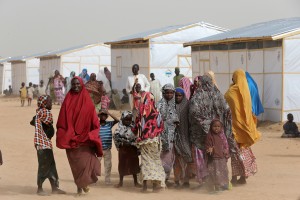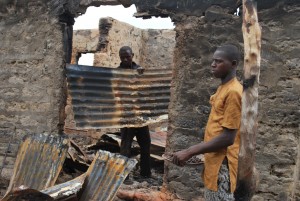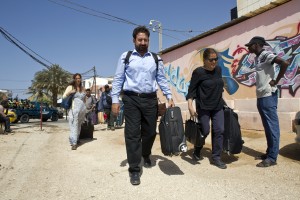Aid workers train for refugee emergencies
UNHCR's Workshop on Emergency Management concludes in Senegal after 10 days of intensive training
THIES, SENEGAL, 21 March 2016 (UNHCR) – Aid workers from as far away as Myanmar, Afghanistan and Colombia have completed a ten-day UNHCR Workshop on Emergency Management (WEM) in Senegal, where they were confronted with the realities of handling a crisis in the deep field. The high-quality workshop took place in Thies from 9 to 18 March.
The WEM training targets selected members of UNHCR’s emergency response team roster and has been a critical component of UNHCR’s emergency response capacity and preparedness for more than 20 years. UNHCR organized its first WEM in Africa last year, in French, and 2016 marks the first anglophone WEM to take place on the continent. The WEM exercise in Senegal involved a combination of classroom training at an army base and four days of field exercises at the Mont Rolland military training ground, located 70 kilometres south of Dakar.
For UNHCR, training its future emergency deployees in simulated field situations is important. “A refugee influx often occurs at a border which may lack basic infrastructure and where aid workers must deal with security issues too,” said Pierre Atchom, Senior Emergency Preparedness and Response Officer for UNHCR. “Participants must be prepared to face difficulties and cope with this environment while ensuring the protection and assistance of refugees.”
Simulation exercises are a fundamental part of UNHCR’s global emergency preparedness training. Participants were put under pressure in various scenarios, while working and living together in very basic conditions in a tented camp. They experienced a simulated refugee influx and had to address human rights issues they might actually face at a real border crossing while coping with a refugee influx of malnourished and dehydrated individuals reporting they are traumatized by brutal attacks.
Participants experienced a kidnapping scenario under the watchful eyes of UN security management specialists. “We were called for an assessment mission to a village where refugees had just arrived, and we fell into an ambush,” said Fatoumata Diallo, Associate Protection Officer, UNHCR Sub Office, Goz-Beida (Chad). “It felt like I was in a real situation. I have never been hooded before, and I have never heard gunshots so close. I was scared.”
“It was very stressful,” said Ahmed Omran, Senior Human Resources Associate in Egypt. “Many of us have never been exposed to such situations, so it’s good for us to get this kind of experience to learn and to be prepared.” A tented camp set amid the semi-arid desert was built by the Senegalese Army to accommodate participants in tents over four days, complete with electricity and mobile toilet and shower units. During the field exercise, participants were divided into four teams and sheltered in two tents each, where they each had to organize their office and sleeping arrangements, much as they might have to do while on an emergency deployment.
“The organization of living arrangements for its emergency training simulations is not a coincidence,” said Peter Kessler, Senior Staff Development Officer at UNHCR’s Global Learning Centre. “Conditions are organized to replicate what the participants might find upon deployment to Tanzania, South Sudan or Malawi. In any situation where they may be sent on emergency missions, they may have to establish a basic camp and organize their own offices”.
The difficult conditions participants faced during the simulation exercises did not weaken their enthusiasm. “Basic structures, such as toilets, food rations and bedding, are available; at least we‘re getting something,” said Younas Sahibzada, Associate Field Officer in Pakistan. “It is challenging for us, and it’s also a good opportunity to be out of our comfort zones. So, it’s really good and we’re learning from each other in our team.”
The purpose of UNHCR’s WEM exercise is to prepare participants for deployment to a two to three month emergency mission. “They have to learn to work in a team and as a team,” said Peter Kessler. “Nothing can be achieved without teamwork, which requires the roster members not only to function successfully as individuals, but also with the existing staff on the ground and the new colleagues arriving on deployment.”
The WEM in Senegal was organized by the UNHCR Global Learning Centre for Emergency Services and UNHCR Representation in West Africa, based in Dakar. Since 1989, more than 3000 people from UNHCR’s operations have been trained and deployed on emergency missions around the world.

Four teams worked on Response plans to a simulated influx of Nigerian refugees in Cameroon. Team Bravo is here finalizing their Plan which included relocating refugees from the volatile border areas to a new camp further inland, detailed map of a new camp, protection concerns such as refoulement and gender-based violence, budget proposals. UNHCR / Helene Caux

Participants of the WEM slept in tents in Mont Rolland, near Thies, in conditions similar to those they would find if they were deployed to real refugee emergency situations. UNHCR / Helene Caux
Les travailleurs humanitaires s’entraînent pour les situations d'urgence de réfugiés
L’Atelier du HCR sur la gestion des urgences (WEM) s’achève au Sénégal après dix jours de formation intensive
THIES, SENEGAL, 21 mars 2016 (UNHCR) - Les travailleurs humanitaires venus de très loin comme du Myanmar, de l'Afghanistan et de la Colombie ont achevé un atelier du HCR de dix journées sur la gestion des urgences au Sénégal, où ils ont été mis en situation réelle de crise d’urgence sur le terrain. Cet atelier de haute qualité a eu lieu à Thiès du 9 au 18 Mars.
La formation au WEM cible des fonctionnaires du HCR pour la composition de l’équipe d’urgence. Depuis plus de 20 ans, le WEM a été un élément essentiel dans sa capacité à préparer les interventions d'urgence. Le HCR a organisé son premier WEM en Afrique l'an dernier, en français, et 2016 marque le premier WEM anglophone sur le continent. L'exercice au Sénégal impliquait une combinaison de formation didactique en classe dans une base de l'armée et quatre jours d'exercices sur le terrain au Mont Rolland, terrain d'entraînement militaire, située à 70 kilomètres au sud de Dakar.
Pour le HCR, la formation de ses futurs déployés d'urgence à travers des exercices de simulations sur le terrain est importante. "Un afflux de réfugiés se produit souvent à une frontière qui peut manquer d’infrastructures de base et où les travailleurs humanitaires doivent faire face également à des problèmes de sécurité», déclare Pierre Atchoum, administrateur principal régional pour la préparation et la réponse aux situations d’urgence au HCR à Dakar. "Les participants doivent être prêts à faire face à des difficultés et s’adapter à cet environnement tout en assurant la protection et l'assistance des réfugiés."
Les exercices de simulation représentent un aspect fondamental de la formation globale du HCR de préparation aux urgences. Les participants ont été mis sous pression dans différents scénarios, tout en travaillant et vivant ensemble dans des conditions très basiques dans un camp de tentes. Ils ont fait l’expérience d’un afflux de réfugiés à travers une simulation et ont au cours de cet exercice, aborder les questions des droits de l’homme auxquelles ils pourraient effectivement être confrontés à la frontière tout en faisant face à un afflux de réfugiés, de personnes souffrant de malnutrition, déshydratées et traumatisés par les attaques brutales dont ils ont été l’objet.
Les participants ont également fait l’expérience d’un scénario d'enlèvement sous le regard attentif des spécialistes de la gestion de la sécurité des Nations Unies. "Nous avons été appelés pour une mission d'évaluation dans un village où les réfugiés venaient d'arriver, et nous sommes tombés dans une embuscade", a déclaré Fatoumata Diallo, chargée de la protection à la Sous-délégation du HCR à Goz-Beida (Tchad). "J’avais l’impression de vivre une situation réelle. Je n’avais jamais été encagoulée et je n’avais jamais entendu des coups de feu de si près. J'étais effrayée."
"C’était très stressant», a déclaré Ahmed Omran, Associé aux ressources humaines en Egypte. "Beaucoup d'entre nous n’ont jamais été exposés à de telles situations, il est donc bon pour nous de vivre ce genre d'expérience pour apprendre et être prêt."
Un camp de tentes avec électricité et équipé de toilettes mobiles et des douches, installé dans le désert semi-aride a été construit par l'armée sénégalaise pour accueillir les participants sur quatre jours. Au cours de l'exercice sur le terrain, les participants ont été divisés en quatre équipes et ont été hébergés dans deux tentes chacune ; ils ont chacun eu à organiser leurs bureaux et les modalités de leur hébergement, autant qu'ils pourraient avoir à le faire lors d'un déploiement d'urgence.
"L'organisation des modes de vie pour ces exercices de simulations au cours de cette formation d'urgence n’est pas une coïncidence", a déclaré Peter Kessler, administrateur principal en charge du perfectionnement du personnel du HCR au Centre global d'apprentissage à Budapest. «Les conditions sont organisées pour reproduire ce que les participants pourraient faire face lors d’un déploiement par exemple en Tanzanie, au Soudan du Sud ou au Malawi. Dans toutes les situations où ils peuvent être envoyés en mission d'urgence, ils peuvent avoir à établir un camp et organiser leurs propres bureaux ".
Les conditions difficiles de vie auxquels les participants font face au cours des exercices de simulation n’ont pas altéré leur enthousiasme. "Les structures de base telles que les toilettes, les rations alimentaires et la literie sont disponibles; au moins nous avons quelque chose", a déclaré Younas Sahibzada, administrateur de terrain au Pakistan. "C’est un défi pour nous, et c’est en même temps une bonne occasion d'être hors de nos zones de confort. C’est vraiment bien et nous apprenons les uns des autres dans notre équipe. "
Le but de l’exercice du WEM du HCR est de préparer les participants à un déploiement de deux à trois mois de mission d'urgence. «Ils doivent apprendre à travailler en équipe et être une équipe», a déclaré Peter Kessler. "Rien ne peut être atteint sans le travail d'équipe, qui exige que les membres, non seulement puissent fonctionner avec succès en tant qu'individus, mais aussi avec le personnel existant sur le terrain et les nouveaux collègues qui arrivent dans le cadre du déploiement."
Le WEM au Sénégal a été organisé par le Centre global d'apprentissage du HCR pour les services d'urgence et la Représentation régionale du HCR en Afrique de l'Ouest, basé à Dakar. Depuis 1989, plus de 3000 personnes provenant des opérations du HCR ont été formés et déployés sur des missions d'urgence dans le monde entier.




















